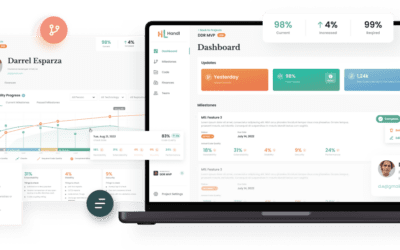Code review comes naturally to any developer. After all, any bugs or errors in the code will often make themselves known—sometimes to the demise of your software. However, engaging a professional code review service can provide a structured and thorough approach to identifying and resolving issues.
On a smaller scale, there’s a virtually endless amount of inefficiencies and inconsistencies that won’t necessarily break your code, but they could create some mega headaches down the road as your software matures and evolves.
A professional code review is one step you can take to make sure your code is in tip-top shape. When you have the extra sets of expert eyes giving it a look-over, you’ll be in a much better position to grow with consistency, reliability, and efficiency. A comprehensive code audit can also be included as part of the service, providing detailed evaluations of your software’s security, performance, and compliance. Code security and adherence to quality standards are key goals of professional code review services, ensuring your software is robust and reliable.
Modern code review services often integrate automated code reviews, seamlessly working with DevOps platforms to enhance the review process and improve development workflows.
What is a professional code review?
A professional code review is a systematic inspection of source code by experienced developers. The goal is high-quality, maintainable, and error-free software—squeaky clean and ready to roll. Code review is a collaborative process that goes beyond basic syntax checking.
An initial review is typically conducted at the beginning of the process to quickly assess the code’s current state before a more detailed analysis. During a professional code review, skilled reviewers will look at various aspects of the codebase to spot potential issues and areas for improvement. These code reviews can be performed through manual reviews, which provide detailed, accuracy-focused feedback, or automated code reviews, which seamlessly integrate with DevOps platforms and version control tools to quickly check code quality. A combination is the most common approach, harnessing the biggest strengths from both people and technology to ensure the code is thoroughly reviewed for quality and security.
What do professional code reviews look at?
Writing beautiful code is an art. Different developers will have different styles, strategies, and opinions, but there are some basics that the best professional code review companies will look at. Reviews typically cover major programming languages to ensure broad applicability. Here are a few:
- Adherence to coding standards. Making sure the code follows established coding standards and conventions, including things like formatting, naming conventions, and style.
- Logic and functionality. Scrutinizing the logic and functionality of the code against requirements, including identifying potential bugs, logic errors, or inefficiencies in algorithm design.
- Error handling and edge cases. Checking if the code adequately addresses potential exceptions and gracefully handles edge cases to make sure there’s no unexpected behavior.
- Scalability and performance. Looking for opportunities to optimize algorithms, minimize resource consumption, and make sure execution is swift and efficient.
- Security vulnerabilities. Checking for secure coding practices, input validation, and protection against common security threats like SQL injection or cross-site scripting.
- Documentation and comments. Making detailed, organized notations to ensure that the code’s purpose, functionality, and usage are clear to developers who may work on it in the future.
- Modularity and maintainability. Assessing whether the code is organized into manageable, reusable components, promoting a structure that facilitates easy updates and enhancements.
- Code structure. Reviewing the organization and clarity of the code structure to ensure maintainability and adherence to best practices.
- Cyclomatic complexity and maintainability index. Evaluating these key metrics to assess code quality, maintainability, and the overall health of the software.
- SOLID principles. Ensuring the code adheres to SOLID principles for better maintainability, scalability, and clean architecture.
- Testing and testability. Assessing whether the code has appropriate unit tests, and reviewing code changes to ensure new modifications meet standards and that changes can be made confidently without introducing unexpected issues.
The benefits of a professional software code review
A professional code review can bring massive benefits to your software and your company as a whole. Code reviews help identify and prioritize critical issues that could impact the stability, security, or functionality of your system. Here are just a few.
Maintainable code is easier to update, debug, and extend, making it much simpler to add new features in the future.
Flat-out better code
- Software code reviews help to catch bugs and errors that may have been missed by compilers and automated testing.
- Enhanced design and architecture lead to more efficient, maintainable, and scalable code.
- Code reviews help to maintain consistency and improve readability, which means stronger adherence to coding standards.
Less time spent, more money saved
- Early issue detection can save a ton of resources as opposed to catching bugs later on.
- Better, faster communication and collaboration mean higher team productivity.
More developer skills and knowledge
- Developers have the opportunity to learn best practices and improve their coding skills by working with experienced reviewers.
- Regular software code reviews help to build a habit of clean code-writing across the whole team.
Code review tools: Types and examples
When you start to dig into the tools and tech behind a code review, you’ll find very quickly that there are a ton of strategies and options. It’s important to choose tools that minimize false positives to ensure your results are accurate and actionable. (But don’t sweat it — once you find the right code review company to help, you’ll be in safe hands. And we can help with that!)
Without throwing you head-first into the deep end, let’s quickly cover some popular types of code review tools and examples of each. The best tools also provide clear reports that are easy to understand and help your team take effective action.
Version control system integrated tools
- GitLab. GitLab provides a comprehensive platform that includes code repositories, CI/CD pipelines, and integrated, secure code review features.
- GitHub. GitHub is a widely used platform that seamlessly integrates with Git. Its pull request feature enables code review, and additional tools like Actions and Discussions supercharge collaboration and automation.
- Bitbucket. Bitbucket by Atlassian offers Git and Mercurial repository management. Its pull request functionality facilitates code review, and it integrates with Jira for seamless issue tracking.
Standalone code review tools
- Crucible. Another Atlassian tool, Crucible is a standalone code review tool that supports Git, Mercurial, and Subversion repositories.
- Phabricator. Phabricator is an open-source suite of tools that includes a code review application.
Automated code analysis tools
- CodeClimate. CodeClimate automates code review by analyzing code for issues related to code smells, duplication, and security vulnerabilities.
- SonarQube. SonarQube is a widely used open-source platform for continuous inspection of code quality.
- Checkmarx. Checkmarx is a secure code review tool that performs vulnerability assessment to identify and fix security vulnerabilities in the code.
- Veracode. Veracode is a cloud-based secure code review platform that offers static code analysis and vulnerability assessment, helping to spot and fix security flaws in the code.
Types of code reviews
Software code reviews are crucial for keeping your codebase efficient and high-quality. The best review method for your team depends on your unique situation, like team location, project urgency, and resource availability. Often, the internal team collaborates with external reviewers during the code review process to ensure thorough feedback and effective implementation. Let’s explore four popular types of code reviews.
1. Asynchronous review
Asynchronous review fits teams in different time zones. Team members work at their own pace. This method is common with GitHub, where reviews also serve as documentation.
Pros:
- Matches personal schedules
- Documents the process automatically
Cons:
- Feedback can be slow
- Important updates might go unnoticed
2. Instant review
Instant review works for teams under tight deadlines. It requires quick thinking in both development and reviewing. The goal is to move from development to testing swiftly.
Pros:
- Speeds up the development cycle
- Perfect for urgent tasks
Cons:
- Can sacrifice detailed documentation
- May affect design quality due to haste
3. Synchronous review
Synchronous review suits urgent fixes or fast-paced updates. It blends detail with speed, especially when the reviewer knows the project well.
Pros:
- Combines thoroughness with quick action
- Useful for immediate needs
Cons:
- Risks rushed approvals
4. Team Review
Team review involves a group of team members, each with a unique role. This method is ideal when there’s enough manpower for an in-depth group analysis.
Pros:
- Brings varied viewpoints for a fuller review
- Helps spread project knowledge
Cons:
- Requires significant time and resources
- Some team members may lack the necessary understanding
The code review process in a nutshell
Code review involves a structured approach to ensure thorough evaluation and improvement of code. Here’s an overview of the steps involved in the process, categorized by phases:
Phase | Step | Description |
|---|---|---|
Before the Review | Understand the code’s purpose | Get what the code is trying to do. This helps you give feedback that makes sense. |
| Determine goals | Set clear, measurable goals for what the review should achieve, and ensure these goals align with the overall development process and project vision. |
| Set expectations | Before sending it in, developers mark their code to spot early issues. |
During the Review | Test functionality | Make sure the code does what it’s supposed to, including any user interface parts. |
| Source code review | Conduct a thorough source code review to identify bugs, security vulnerabilities, and architectural issues. |
| Inspect code quality | Look at the code’s style, naming, and error handling to make sure it’s up to standard. |
| Manage time | Keep review sessions short and sweet, about 60-90 minutes, with breaks to stay sharp. |
| Review documentation | Go over documents related to the project to keep everyone on the same page. |
After the Review | Verify fixes | After finding problems, double-check they’re actually fixed. |
| Check regularly | Doing reviews often keeps everyone on their toes. |
| Utilize tools | Tools can make the review process smoother and more accurate. |
| Foster team growth | Use the review as a chance for the team to learn and grow together. |
| Track metrics | Keep track of how things are going. Set and follow clear goals. |
| Consider code audit | For a more comprehensive evaluation, a code audit may be performed to assess system security, performance, and compliance. |
Code analysis and audit
Code analysis and audit are foundational steps in the professional code review process. By thoroughly examining the source code, experienced developers can identify potential issues, security vulnerabilities, and opportunities for improvement that might otherwise go unnoticed. A comprehensive code analysis goes beyond surface-level checks, diving deep into the logic, structure, and flow of the code to catch bugs, logic errors, and areas where the code may not meet the highest standards.
Professional code review services leverage both manual review and automated tools to analyze code, ensuring that every aspect of the software is scrutinized. This process results in detailed descriptions of findings, including specific recommendations for remediation. By systematically analyzing code, teams can prevent memory leaks, improve maintainability, and ensure that the software meets rigorous quality, security, and performance benchmarks. Ultimately, code analysis and audit are essential for delivering high quality code that stands the test of time.
Memory leaks and performance
Memory leaks and performance issues can quietly undermine even the most promising software projects. During a code review, experienced developers and review services focus on identifying these hidden problems by analyzing how the code manages resources and executes critical operations. Memory leaks—where memory is allocated but not properly released—can lead to slowdowns, crashes, and security vulnerabilities if left unchecked.
A thorough code review helps pinpoint areas where memory management can be improved and where performance bottlenecks may exist. Reviewers provide actionable feedback on optimizing code, ensuring that the software not only runs efficiently but also remains stable and secure under real-world conditions. By addressing memory leaks and performance issues early, development teams can uphold the highest standards of software quality and security, delivering a smoother, more reliable user experience.
Quality and security standards
Adhering to quality and security standards is non-negotiable in modern software development. A professional code review plays a critical role in ensuring that code aligns with industry-standard coding practices and meets all required security benchmarks. Review services meticulously examine the codebase for compliance with established coding standards, best practices, and naming conventions, as well as for the presence of any security vulnerabilities or bugs.
By following a structured review process, developers receive a detailed report outlining areas where the code excels and where improvements are needed. This not only helps maintain a high level of code quality and security but also ensures that the software performs reliably in production. Regular code reviews reinforce a culture of excellence, enabling teams to deliver software that is robust, secure, and future-proof.
Remediation guidance
Remediation guidance is a vital outcome of the code review process. After identifying issues such as security vulnerabilities, logic errors, or performance bottlenecks, professional code review services provide developers with clear, actionable recommendations for fixing them. These detailed descriptions help teams understand the root causes of problems and prioritize remediation efforts based on severity and impact.
Effective remediation guidance includes step-by-step suggestions, best practices for secure coding, and estimated timelines for addressing each issue. This empowers developers to efficiently resolve bugs and vulnerabilities, ensuring that the software meets the highest standards of quality, security, and performance. By following expert remediation guidance, teams can continuously improve their codebase and deliver safer, more reliable software.
Code review best practices
As you do a code review, keep these best practices in mind to make the most of this software quality assurance activity: ensure all code is thoroughly reviewed according to best practices to maintain high standards and catch potential issues early.
1. Limit code submission size
When submitting code for review, especially in a stale codebase, break your work into smaller chunks. Aim for pull requests of about 10 to 100 lines. This makes it easier for reviewers to spot issues and provide meaningful feedback.
2. Provide comprehensive descriptions
Accompany your code submissions with detailed descriptions. Explain what the code does, the problem it solves, or link it to related bug reports. This context is crucial for effective and secure code review and helps reviewers understand your thought process.
3. Communicate clearly
As a reviewer, be explicit in your comments. If a suggestion is optional, state it clearly. This clarity is vital in code peer reviews. It prevents misunderstandings and helps the submitter to prioritize actions.
4. Preemptively explain unrelated changes
If your submission includes changes that aren’t directly related to the main logic (like those needed in code rescue situations), add a comment explaining why. This heads off confusion and helps reviewers understand the necessity of these changes.
5. Establish review approval guidelines
With your team, set clear standards for approving or rejecting pull requests. This is especially important in code restructuring. Your standard-setting might include defining what constitutes a blocker issue or the level of test coverage required. Clear standards ensure consistency in your review process.
6. Choose the right review workflow
Decide with your team whether you’ll do traditional gateway reviews, knowledge-sharing reviews, or early design feedback. The choice should align with your project’s needs and team structure. For instance, choose knowledge-sharing reviews to enhance team understanding of the codebase.
Code review checklist
A code review checklist is an indispensable tool for ensuring that every aspect of the code is thoroughly evaluated. By following a comprehensive checklist, developers and reviewers can systematically assess code quality, security vulnerabilities, performance issues, and areas for improvement. Here’s what a robust code review checklist should include:
- Code quality: Verify adherence to coding standards, proper naming conventions, and best coding practices to ensure readability and maintainability.
- Security vulnerabilities: Check for common threats such as cross site scripting, SQL injection, and other security flaws that could compromise the software.
- Performance issues: Identify memory leaks, performance bottlenecks, and opportunities for optimization to enhance the software’s speed and efficiency.
- Areas for improvement: Look for sections of code that could benefit from refactoring, simplification, or the use of reusable components.
Using a code review checklist helps ensure that the code meets all required standards of quality, security, and performance. It also provides a clear, detailed report of findings and recommendations, making it easier for developers to address issues and deliver high quality, secure software.
Making sure you get the job done well
Sure, you can get by with code that just barely gets the job done. But down the road when it’s time for updates and enhancements, you might find yourself in a pickle.
The best way to make sure you have grade-A code that stays maintainable, consistent, and reliable is doing it right the first time. A professional code review makes sure that your software gets attention from experts in the field who know how to make it the best it can be. For even greater assurance, a comprehensive code audit can identify security risks, performance issues, and compliance gaps before deployment or during ongoing maintenance.
If you’re looking for a partner with a strong track record and seasoned expertise, choose a code review service with proven results—the Dazlab team can help get you where you want to go.




